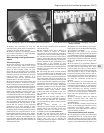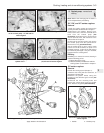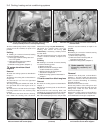
crankpin and both bearing shells. Taking care
not to mark the cylinder/liner bores, pull the
piston/connecting rod assembly down the
bore and onto the crankpin. Refit the big-end
bearing cap, tightening its retaining nuts
finger-tight at first. Note that the faces with
the identification marks must match (which
means that the bearing shell locating tabs
abut each other).
22 On XV, XW, XY and TU series engines,
tighten the bearing cap retaining nuts evenly
and progressively to the specified torque
setting (see illustration).
23 On XU series engines, tighten the bearing
cap retaining nuts evenly and progressively to
the Stage 1 torque setting. Fully slacken both
nuts, then tighten them to the Stage 2 torque
setting. Once both nuts have been tightened
to the Stage 2 setting, angle-tighten them
through the specified Stage 3 angle, using a
socket and extension bar. It is recommended
that an angle-measuring gauge is used during
this stage of the tightening, to ensure
accuracy (see illustration). If a gauge is not
available, use a dab of white paint to make
alignment marks between the nut and bearing
cap prior to tightening; the marks can then be
used to check that the nut has been rotated
sufficiently during tightening.
24 On XU and TU series engines, once the
bearing cap retaining nuts have been correctly
tightened, rotate the crankshaft. Check that it
turns freely; some stiffness is to be expected
if new components have been fitted, but there
should be no signs of binding or tight spots.
25 On XU and TU series engines, refit the
remaining three piston/connecting rod
assemblies in the same way.
26 On XV, XW and XY series engines,
continue the crankshaft refitting procedure
described in Section 13. On all other engines,
refit the cylinder head and oil pump as
described in Part B or C of this Chapter (as
applicable).
15 Engine - initial start-up after
overhaul
1 With the engine refitted in the vehicle,
double-check the engine oil and coolant
levels. Make a final check that everything has
been reconnected, and that there are no tools
or rags left in the engine compartment.
2 Remove the spark plugs. On models with a
distributor, disable the ignition system by
disconnecting the ignition HT coil lead from
the distributor cap, and earthing it on the
cylinder block. Use a jumper lead or similar
wire to make a good connection. On models
with a static (distributorless) ignition system,
disable the ignition system by disconnecting
the LT wiring connector from the ignition
module, referring to Chapter 5B for further
information.
3 Turn the engine on the starter until the oil
pressure warning light goes out. Refit the
spark plugs, and reconnect the spark plug
(HT) leads, referring to Chapter 1 for further
information. Reconnect any HT leads or wiring
which was disconnected in paragraph 2.
4 Start the engine, noting that this may take a
little longer than usual, due to the fuel system
components having been disturbed.
5 While the engine is idling, check for fuel,
water and oil leaks. Don’t be alarmed if there
are some odd smells and smoke from parts
getting hot and burning off oil deposits.
6 Assuming all is well, keep the engine idling
until hot water is felt circulating through the
top hose, then switch off the engine.
7 Check the ignition timing and the idle speed
settings (as appropriate), then switch the
engine off.
8 After a few minutes, recheck the oil and
coolant levels as described in Chapter 1, and
top-up as necessary.
9 On XV, XW and XY series engines, and XU
series engines with hexagon type cylinder
head bolts, it will be necessary to re-tighten
the head bolts after the engine has been run
up to normal working temperature then
switched off and allowed to cool (see Part A
and B of this Chapter, as applicable). On all
other engines, if they were tightened as
described, there is no need to re-tighten the
cylinder head bolts once the engine has first
run after reassembly.
10 If new pistons, rings or crankshaft
bearings have been fitted, the engine must be
treated as new, and run-in for the first 500
miles (800 km). Do not operate the engine at
full-throttle, or allow it to labour at low engine
speeds in any gear. It is recommended that
the oil and filter be changed at the end of this
period.
2D•24 Engine removal and overhaul procedures
14.19 Tap the piston into the bore using a
hammer handle
14.22 Tightening a big-end bearing cap
nut using a torque wrench . . .
14.23 . . . and further, on XU series
engines, through the specified angle using
an angle tightening gauge


















